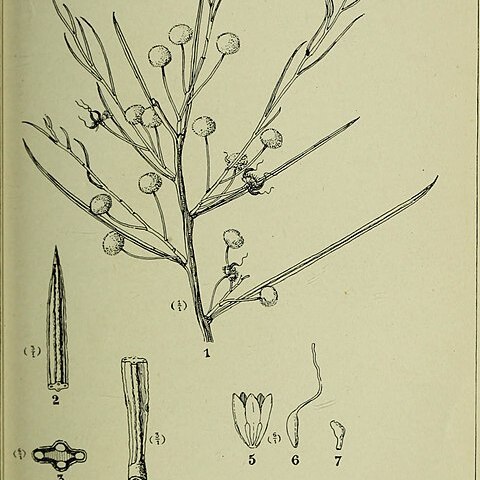Bushy glabrous shrub or tree 1.5–3 m high, sometimes 5 m. Branchlets angled at extremities, sometimes viscid especially on the fine yellow ribs. Phyllodes ascending to erect, usually linear, occasionally filiform, flat to quadrangular, 2–11 cm long, usually 0.5–3 mm wide, commonly pungent, smooth, normally subglaucous to glaucous; midrib and marginal veins prominent, yellowish and sometimes viscid; lateral veins absent; gland 2–20 mm above pulvinus, and sometimes also 3–20 mm below apex. Inflorescences 3–7-headed racemes; raceme axes 3-15 mm long, enclosed when young by imbricate brown bracts; peduncles 4–11 mm long, slender; heads showy, globular, 10–24-flowered, light golden; bracteoles absent. Flowers 5-merous; sepals free. Pods rounded over seeds, often curved, to 8.5 cm long, 5–7 mm wide, firmly chartaceous. Seeds longitudinal, oblong-elliptic to ovate, 3.5–6 mm long, slightly shiny, black, exarillate.
More
A shrub or bushy tree. It grows about 3 m tall. The branches are angled at the ends. The flowers are yellow. The pods are 8.5 cm long and 5-7 mm wide. They are curved and rounded over the seeds. The seeds are oval and 4-6 mm long. They are a shiny black.
Arid and semi-arid regions, growing in sand or sandy clay in open scrub, mallee communities, Eucalyptus woodland or spinifex country.
More
Grows in sand or sandy clay in open scrub, mallee communities, Eucalyptus woodland or spinifex country.
Can be grown by seedlings. Seeds needs soaking.


